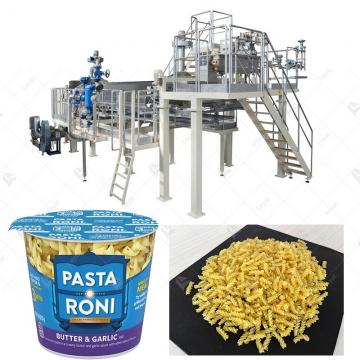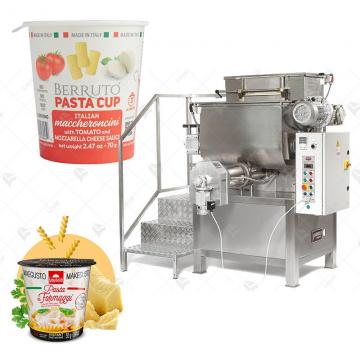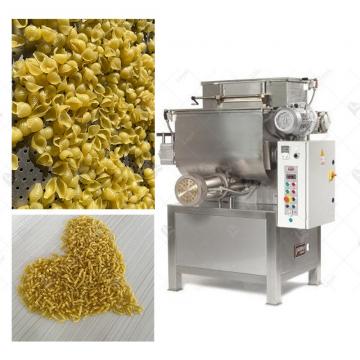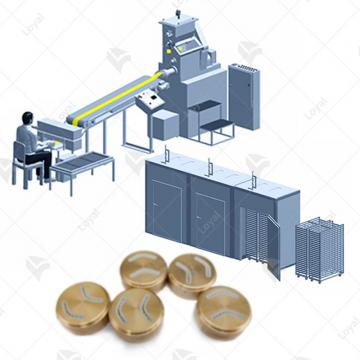
- Shandong Loyal Industrial Co.,Ltd.
- SHORT-CUT PASTA PRODUCTION LINE LONG-CUT PASTA PRODUCTION LINE INSTANT PASTA PRODUCTION LINE
Home> Company News> The Ultimate Guide to Dry Pasta Press Machines in 2024

The Ultimate Guide to Dry Pasta Press Machines in 2024
2024-03-28 11:12:37Combined Pasta Machines are sophisticated pieces of equipment designed to streamline the pasta production process. These machines are equipped with advanced features and capabilities to handle various aspects of pasta making, from dough preparation to shaping and cutting. By consolidating multiple functions into one unit, combined pasta machines optimize space utilization and minimize the need for manual intervention.
Components and Working Mechanism of Combined Pasta Machines
Combined pasta machines are intricate systems designed to streamline the pasta production process, whether it be for short-cut or long-cut varieties. Understanding the components and working mechanism of these machines is essential for optimizing efficiency and ensuring quality in pasta manufacturing.
Mixing Hopper and Feeding System:The mixing hopper is where the ingredients for pasta dough are combined. It typically includes compartments for flour, water, and any additional ingredients. The feeding system then transports the dough mixture to the next stage of the process.
Extrusion System:The extrusion system is the heart of the combined pasta machine. It consists of a series of augers and dies that shape the pasta dough into the desired form. For short-cut pasta production lines, the dies are configured to produce shapes like penne, fusilli, or macaroni. In contrast, for long-cut pasta production lines, the dies create continuous strands of pasta, such as spaghetti or fettuccine.
Cutting Mechanism:In short-cut pasta production lines, a cutting mechanism is integrated into the extrusion system to portion the pasta into individual shapes. This mechanism may consist of rotating blades or wire cutters, depending on the specific design of the machine. For long-cut pasta production lines, no cutting mechanism is necessary as the pasta emerges in continuous strands.
Drying Chamber:Once the pasta shapes are formed, they need to be dried to achieve the desired texture and shelf stability. The drying chamber of a combined pasta machine facilitates this process by providing controlled airflow and temperature settings. The pasta shapes are typically transported through the drying chamber on conveyor belts, allowing for uniform drying.
Control Panel and Automation Features:Modern combined pasta machines often include advanced control panels and automation features to monitor and regulate the production process. Operators can adjust parameters such as extrusion speed, drying temperature, and cutting frequency to optimize performance and ensure consistent quality. Additionally, sensors and alarms alert operators to any deviations from the set parameters, allowing for timely intervention.
Understanding the intricate components and working mechanism of combined pasta machines is essential for maximizing productivity and maintaining quality standards in pasta production. By investing in advanced machines with robust features and automation capabilities, manufacturers can enhance efficiency and meet the diverse demands of the market.
Importance Combined Pasta Machines in the Pasta Production Industry
Combined pasta machines play a crucial role in the pasta production industry due to their efficiency, versatility, and cost-effectiveness. By combining multiple functions into one machine, they enable pasta manufacturers to streamline their production processes, reduce labor costs, and increase overall productivity. These machines are particularly valuable for large-scale pasta production operations, where efficiency and consistency are paramount.
The integration of short-cut pasta production lines and long-cut pasta production lines into combined pasta machines further enhances their utility and versatility. Short-cut pasta production lines are optimized for producing pasta shapes like penne, fusilli, and macaroni, while long-cut pasta production lines are tailored for spaghetti, linguine, and fettuccine. Combined pasta machines offer manufacturers the flexibility to produce a wide range of pasta varieties efficiently and economically, catering to diverse consumer preferences and market demands.
Combined pasta machines represent a significant advancement in pasta manufacturing technology, offering unparalleled efficiency, versatility, and cost-effectiveness. As the demand for high-quality pasta continues to grow, these machines are poised to play an increasingly important role in the pasta production industry, driving innovation and shaping the future of pasta manufacturing.
Advantages of Using Combined Pasta Machines
Increased Efficiency:Utilizing a combined pasta machine offers significant advantages in terms of efficiency. These machines integrate multiple pasta production processes into a single system, eliminating the need for separate equipment for each stage of production. By streamlining the manufacturing process, combined pasta machines can significantly reduce production time and labor costs.
Versatility in Pasta Production:One of the key benefits of combined pasta machines is their versatility in producing various types of pasta. Whether it's short-cut or long-cut pasta, these machines can adapt to different shapes and sizes with ease. This versatility allows pasta manufacturers to meet diverse consumer demands and expand their product offerings without the need for multiple production lines.
Consistent Quality:Consistency is crucial in pasta production to maintain the desired texture, taste, and appearance of the final product. Combined pasta machines are designed to ensure consistent quality across all batches of pasta. By controlling factors such as dough consistency, extrusion pressure, and cutting precision, these machines produce uniform pasta shapes and sizes with minimal variation.
Cost Savings:Investing in a combined pasta machine can result in significant cost savings for pasta manufacturers. By consolidating multiple production processes into a single machine, manufacturers can reduce the need for additional equipment and infrastructure, saving both space and capital expenditure. Additionally, the efficiency of combined pasta machines can lead to lower energy consumption and operational costs over time.
Enhanced Control and Customization:Modern combined pasta machines are equipped with advanced control systems that offer greater flexibility and customization options. Operators can adjust parameters such as dough consistency, extrusion speed, and cutting specifications to tailor the pasta production process to specific requirements. This level of control ensures optimal results and allows manufacturers to innovate and experiment with new pasta recipes and formulations.
Overview of Sectors Utilizing Combined Pasta Machines
The combined pasta machine has revolutionized pasta production across various industries. In the food manufacturing sector, it serves as a versatile solution for producing a wide range of pasta products efficiently and cost-effectively. From large-scale pasta manufacturers to small-scale pasta artisans, the combined pasta machine caters to diverse production needs.
One prominent application of the combined pasta machine is in short-cut pasta production lines. These lines are commonly found in pasta factories and industrial kitchens where there is a high demand for pasta products such as penne, fusilli, and macaroni. The combined pasta machine enables the automated production of short-cut pasta varieties, ensuring consistent quality and output.
In addition to short-cut pasta, the combined pasta machine also finds extensive use in long-cut pasta production lines. Long-cut pasta, including spaghetti, fettuccine, and linguine, requires specialized equipment for efficient production. The combined pasta machine offers the flexibility and precision required to produce long-cut pasta at scale, meeting the demands of pasta manufacturers worldwide.
The versatility of the combined pasta machine extends beyond traditional pasta production facilities. It is also utilized in the hospitality industry, where pasta dishes are a staple on menus of restaurants, hotels, and catering services. By incorporating the combined pasta machine into their operations, businesses in the hospitality sector can streamline pasta preparation, reduce labor costs, and ensure consistent pasta quality.
Furthermore, the combined pasta machine has gained traction in the emerging trend of customized pasta production. With consumers increasingly seeking unique pasta shapes and flavors, the combined pasta machine offers the capability to experiment and innovate. Artisanal pasta makers and specialty food stores utilize these machines to create bespoke pasta products tailored to specific customer preferences and dietary requirements.
Market Analysis of Combined Pasta Machines
In the realm of pasta production, the utilization of combined pasta machines has revolutionized the industry, streamlining processes and enhancing efficiency. Let's delve into a comprehensive market analysis to understand the current landscape and future trends surrounding these machines.
The market for combined pasta machines is experiencing steady growth globally. As pasta consumption continues to rise worldwide, manufacturers are increasingly turning to these advanced machines to meet the escalating demand. From large-scale pasta production facilities to smaller artisanal pasta makers, there is a widespread recognition of the benefits offered by combined pasta machines in enhancing productivity and quality.
One notable trend in the market is the expansion of short-cut pasta production lines equipped with combined pasta machines. Short-cut pasta varieties such as penne, fusilli, and farfalle are immensely popular among consumers due to their versatility and quick cooking times. Manufacturers are investing in advanced machinery to cater to this growing demand for short-cut pasta products, driving the adoption of combined pasta machines in this segment.
Similarly, long-cut pasta production lines are also witnessing a surge in the adoption of combined pasta machines. Traditional long-cut pasta shapes like spaghetti, linguine, and fettuccine remain staple favorites among consumers worldwide. To meet the demand for these classic pasta varieties while maintaining efficiency, manufacturers are integrating combined pasta machines into their production lines, optimizing the pasta-making process from dough preparation to packaging.
The market for combined pasta machines is characterized by ongoing technological advancements and innovations. Manufacturers are continually enhancing machine capabilities, incorporating features such as automated dough mixing, precision cutting mechanisms, and advanced control systems. These innovations not only improve productivity but also enable greater customization and flexibility in pasta production, catering to evolving consumer preferences.
The market for combined pasta machines is highly competitive, with key players vying for market share across regions. Leading manufacturers are focusing on product innovation, strategic partnerships, and market expansion to maintain a competitive edge. Additionally, factors such as economic conditions, regulatory policies, and consumer trends play a significant role in shaping the global market dynamics for combined pasta machines.
Main Manufacturers and Brands
Shandong Loyal Industrial Co., Ltd. is a pioneer company that seamlessly integrates Italian vacuum extrusion technology into its operations. With the expertise and technical support of Italian engineers, the company successfully developed an advanced vacuum extruded pasta production line. The company's product line features a wide range of pasta varieties, including spaghetti, fillini, shells, fusilli, rigatoni, rigatoni and more. Our adherence to Italian technical standards ensures the production of high-quality pasta with excellent taste and visual appeal. The company's production capabilities cover both matte and glossy types of pasta.
Shandong Loyal Industrial Co., Ltd. is committed to providing comprehensive solutions and understands the importance of reducing labor costs and operational complexity for customers. We are proud to offer complete production line configurations, including temporary storage systems for raw materials and finished products, drying systems, automatic packaging solutions, and strong technical support services. The company's commitment extends to after-sales maintenance services, ensuring the longevity and optimal performance of your pasta production units.
Types of Combined Pasta Machines
Combined pasta machines are essential equipment in pasta production facilities, offering versatility and efficiency in the manufacturing process. Understanding the different types of combined pasta machines is crucial for selecting the most suitable option for specific production needs. Let's explore the various types in detail:
Continuous Combined Pasta Machines:Continuous combined pasta machines are designed for high-volume production, offering a continuous and automated pasta-making process. These machines typically consist of multiple interconnected units, including dough mixing, extrusion, cutting, and drying components. They are ideal for large-scale operations where efficiency and productivity are paramount.
Batch Combined Pasta Machines:Batch combined pasta machines are suitable for smaller-scale production or for manufacturing specialty pasta products. Unlike continuous machines, batch machines operate in batches, allowing for greater flexibility and customization in the production process. They are often used in artisanal pasta-making operations or for producing limited quantities of specialty pasta varieties.
Integrated Short-Cut and Long-Cut Pasta Machines:Some combined pasta machines are designed to produce both short-cut and long-cut pasta varieties within the same system. These integrated machines offer versatility and efficiency, allowing manufacturers to switch between different pasta shapes and sizes with ease. They are ideal for facilities that require the flexibility to produce a wide range of pasta products.
Modular Combined Pasta Machines:Modular combined pasta machines feature a modular design, allowing for easy customization and scalability. Manufacturers can add or remove modules according to their specific production requirements, making them highly adaptable to changing needs. Modular machines offer the advantage of scalability, allowing manufacturers to expand their production capacity as needed.
Customized Combined Pasta MachinesFor unique or specialized pasta production requirements, customized combined pasta machines offer tailored solutions to meet specific needs. These machines are designed and built to order, taking into account factors such as production volume, pasta shapes, and processing requirements. Customized machines offer maximum flexibility and efficiency, ensuring optimal performance for individual production facilities.
Maintenance and Care Tips for Extending Machine Lifespan
Maintenance plays a crucial role in ensuring the optimal performance and longevity of combined pasta machines. These machines are essential in both short-cut and long-cut pasta production lines, where they streamline the pasta-making process. Proper maintenance not only helps prevent breakdowns but also extends the lifespan of the equipment, ensuring smooth operations and consistent product quality.
One of the fundamental aspects of maintenance for combined pasta machines is regular cleaning and lubrication. Dust, flour residue, and other debris can accumulate on various components, leading to friction and wear. Regularly clean the machine's surfaces and components with a soft cloth and ensure that all moving parts are properly lubricated to reduce friction and prevent premature wear.
Regular inspection of the machine's components is essential for identifying signs of wear and tear. Check belts, chains, gears, and bearings for any damage or signs of deterioration. Replace any worn-out parts promptly to prevent further damage and ensure the machine operates smoothly. Additionally, consider investing in high-quality, durable replacement parts to prolong the lifespan of the machine.
Periodically calibrating and adjusting the settings of the combined pasta machine is necessary to maintain optimal performance. Check the alignment of rollers, cutting blades, and other components to ensure they are properly aligned and functioning correctly. Make any necessary adjustments according to the manufacturer's specifications to ensure consistent product quality and minimize wear on the machine.
Proper training of machine operators is essential for ensuring that maintenance tasks are performed correctly and safely. Educate operators on the importance of regular maintenance and provide training on how to perform routine tasks such as cleaning, lubrication, and inspection. Emphasize safety practices to prevent accidents and injuries during maintenance activities. By investing in operator training and promoting a culture of safety, manufacturers can ensure that maintenance tasks are performed effectively and safely, contributing to the extended lifespan of the combined pasta machines.
Engineer Training is Essential
Enhanced Machine Operation Skills:Engineer training equips operators with the necessary skills to effectively operate combined pasta machines and pasta production lines. This includes understanding machine controls, settings, and safety procedures to ensure smooth and efficient operation.
Optimized Maintenance Practices:Proper engineer training enables maintenance personnel to conduct regular inspections, troubleshoot issues, and perform preventive maintenance tasks on combined pasta machines and production lines. This helps prevent costly breakdowns and ensures continuous production.
Troubleshooting Abilities:Engineer training empowers operators to identify and address common issues that may arise during pasta production, such as equipment malfunctions or quality deviations. By possessing troubleshooting skills, engineers can minimize downtime and maintain product quality.
Adaptability to New Technologies:As pasta manufacturing technologies evolve, engineer training ensures that personnel remain up-to-date with the latest advancements. This enables engineers to adapt quickly to new features, software updates, and automation technologies incorporated into modern pasta machines and production lines.
Safety Compliance and Risk Reduction:Engineer training emphasizes the importance of safety protocols and procedures in operating and maintaining pasta machines and production lines. Proper training reduces the risk of accidents and injuries, creating a safer working environment for all personnel involved in pasta production.
Troubleshooting Common Issues with Combined Pasta Machines
1. Dough Stickiness
One common issue encountered with combined pasta machines is dough stickiness during the production process. This can occur due to various factors, including improper dough consistency or inadequate machine maintenance.
To address this issue, it is essential to ensure that the dough is prepared with the correct consistency, neither too dry nor too wet. Additionally, regularly cleaning and lubricating the machine's components, especially the rollers and cutting blades, can help prevent dough from sticking during operation.
2. Uneven Pasta Thickness
Another common problem is the production of pasta with uneven thickness, which can affect the overall quality and appearance of the final product. This issue may arise due to misalignment of the machine's rollers or improper adjustment of the pressure settings.
To resolve this issue, carefully inspect the machine's rollers for any signs of misalignment and adjust them as needed to ensure they are evenly spaced. Additionally, adjust the pressure settings according to the manufacturer's recommendations to achieve uniform pasta thickness.
3. Motor Overheating
Motor overheating is a common issue that can occur with combined pasta machines, especially during prolonged operation or when processing large batches of pasta. This issue may result from insufficient ventilation around the motor or overloading of the machine.
To prevent motor overheating, ensure that the machine is operated within the recommended capacity limits and allow for adequate airflow around the motor. If overheating occurs frequently, consider installing additional cooling mechanisms or upgrading to a more powerful motor.
4. Jamming or Clogging
Jamming or clogging of the machine's components, such as the extruder or cutting blades, can disrupt the production process and lead to downtime. This issue may occur due to the accumulation of dough or debris in the machine's mechanisms.
To resolve jamming or clogging issues, regularly inspect the machine's components for any signs of buildup and clean them thoroughly to remove any debris. Additionally, ensure that the machine's settings are adjusted correctly to prevent excessive pressure or force during operation.
5. Vacuum System Malfunction
The vacuum system plays a crucial role in the operation of combined pasta machines, as it helps to remove air from the dough and maintain the desired texture and consistency of the pasta. However, malfunctions in the vacuum system, such as leaks or blockages, can disrupt the production process.
To troubleshoot vacuum system malfunctions, carefully inspect the system for any signs of leaks or blockages and address them promptly. Clean or replace filters as needed, and ensure that the vacuum pump is properly maintained to prevent malfunctions. Additionally, monitor vacuum pressure during operation to ensure consistent performance.
Sustainability Practices in Pasta Production
In the realm of pasta production, the emphasis on sustainability has become increasingly paramount. Combined pasta machine, short-cut pasta production line, and long-cut pasta production line are integral components of this eco-conscious movement, offering innovative solutions to minimize environmental impact. Let's delve into the sustainable practices and eco-friendly machine options that are shaping the future of pasta manufacturing.
Sustainability is at the forefront of modern pasta production, with companies actively seeking ways to reduce their environmental footprint. One key strategy involves the adoption of combined pasta machines, which integrate various stages of the pasta-making process into a single efficient system. By streamlining operations, these machines not only enhance productivity but also reduce energy consumption and waste generation.
Furthermore, the implementation of short-cut pasta production lines and long-cut pasta production lines plays a pivotal role in sustainable pasta manufacturing. Short-cut pasta, such as penne and fusilli, requires different processing techniques compared to long-cut varieties like spaghetti and fettuccine. By utilizing specialized production lines tailored to each pasta type, manufacturers can optimize efficiency and minimize resource usage.
In addition to advanced machinery, sustainability in pasta production extends to eco-friendly practices throughout the supply chain. This includes sourcing ingredients from local and organic suppliers, reducing water usage during processing, and implementing energy-efficient technologies in production facilities. By prioritizing these initiatives, pasta manufacturers can significantly reduce their environmental impact while meeting consumer demand for sustainable products.
When considering eco-friendly machine options, manufacturers have a range of choices to support their sustainability goals. Investing in energy-efficient equipment, such as pasta extruders with high-performance motors and automated systems, can lead to substantial reductions in energy consumption and operating costs.
Future Trends and Developments in Combined Pasta Machine Technology
One of the most notable predictions for the future of combined pasta machine technology is the integration of artificial intelligence (AI) and machine learning algorithms. These advancements will enable combined pasta machines to optimize production processes with unprecedented precision and efficiency. By analyzing vast amounts of data in real-time, AI-powered systems can fine-tune parameters such as dough consistency, extrusion speed, and cutting techniques to achieve optimal results consistently. This integration of AI promises to streamline operations and minimize waste, driving significant cost savings for pasta manufacturers.
Another emerging trend in the realm of combined pasta machines is the increasing focus on sustainability and eco-friendliness. With growing consumer awareness of environmental issues, pasta producers are under pressure to minimize their carbon footprint and adopt more sustainable practices. In response to this demand, manufacturers are developing combined pasta machines equipped with advanced recycling and waste management features. These machines utilize innovative technologies to recycle water, minimize energy consumption, and reduce material waste throughout the production process. By embracing sustainability, pasta manufacturers can not only reduce their environmental impact but also appeal to environmentally conscious consumers, gaining a competitive edge in the market.
Furthermore, the future of combined pasta machine technology is likely to be shaped by the rise of smart manufacturing and the Internet of Things (IoT). By connecting combined pasta machines to a network of sensors and devices, manufacturers can create interconnected production environments capable of real-time monitoring and optimization. This interconnectedness enables seamless communication between different stages of the pasta production process, allowing for agile adjustments and proactive maintenance. Through the adoption of IoT-enabled combined pasta machines, manufacturers can enhance productivity, minimize downtime, and ensure consistent product quality, driving overall efficiency and profitability.
Introduction
Combined pasta machines revolutionize pasta production by integrating both short-cut and long-cut pasta production lines into a single, efficient system. This innovation streamlines the manufacturing process, offering versatility and maximizing productivity. In this article, we delve into the intricacies of combined pasta machines, exploring their features, benefits, and future prospects.These machines boast versatility, enabling producers to switch between different pasta types swiftly. The integration of diverse production capabilities optimizes space utilization and reduces operational costs significantly.
As technology advances and consumer preferences evolve, the future of combined pasta machines looks promising. Innovations in automation, materials, and design are anticipated to further optimize production processes and enhance product quality. Additionally, advancements in sustainability and resource efficiency will likely drive the development of eco-friendly pasta manufacturing solutions. Overall, combined pasta machines are poised to remain at the forefront of pasta production, driving efficiency, quality, and sustainability in the years to come.
References
1. Barilla Group: Barilla is a renowned Italian food company known for its pasta products, including various types of penne pasta. Their official website provides information about their products, including nutritional information, recipes, and cooking tips. Website: https://www.barillagroup.com
2. De Cecco: De Cecco is another well-known Italian pasta manufacturer with a long history of producing high-quality pasta products, including penne. Their website offers a comprehensive overview of their product range, along with recipes and cooking instructions. Website: https://www.dececco.com
3. Panzani: Panzani is a French-Italian food company specializing in pasta products, including various types of penne pasta. Their website provides details about their product range, along with recipes and cooking inspiration. Website: https://www.panzani.fr
4. International Pasta Organization (IPO) - The official website of the International Pasta Organization provides valuable resources and publications related to pasta production, including industry reports, research papers, and technical guidelines. Website: http://www.internationalpasta.org/
5. National Pasta Association (NPA) - The National Pasta Association is a leading trade organization for the pasta industry in the United States. Their website features educational resources, research reports, and industry insights related to pasta production and consumption trends. Website: https://www.pastafits.org/
 Instant Pasta Production Line
Instant Pasta Production Line INSTANT PASTA CUP PRODUCTION LINE
INSTANT PASTA CUP PRODUCTION LINE PRECOOKED PASTA PRODUCTION LINE
PRECOOKED PASTA PRODUCTION LINE Dry Pasta Production Line
Dry Pasta Production Line